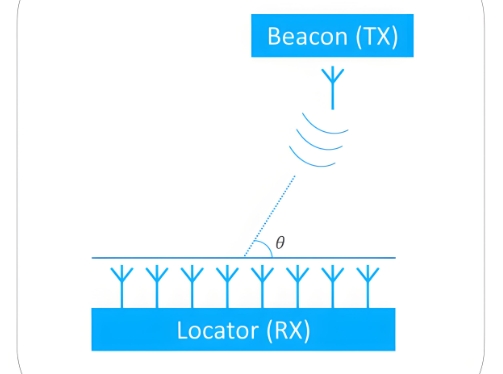In many fields such as wireless communication, radar detection, and acoustic positioning, the angle of arrival (AOA) is a crucial parameter. It can accurately determine the direction of the signal source relative to the receiving point, providing key information for applications such as positioning, tracking, and navigation. Whether it is the precise positioning of enemy targets in the military or the indoor and outdoor positioning of mobile devices in the civilian field, the angle of arrival plays an indispensable role. So, how to find the angle of arrival?

Antenna array-based method
Antenna array is a common and effective means to obtain angle of arrival information. A simple linear antenna array is a straight line arranged with multiple antenna units at a certain spacing. When the signal reaches the antenna array, due to the difference in the distance between different antenna units and the signal source, the time for the signal to reach each antenna unit will be different, resulting in a phase difference. By measuring these phase differences and combining the spacing between antenna units and the wavelength of the signal, the angle of arrival can be calculated using a specific formula. For example, in a uniform linear array, by analyzing the phase difference of the signals received by adjacent antennas and combining the geometric relationship, the incident direction of the signal can be derived.
The circular antenna array further expands the measurement range and accuracy. It consists of multiple antenna units evenly distributed on the circumference. When the signal reaches the circular array, the signals received by different antenna units will be different in amplitude and phase. Through the comprehensive analysis of these amplitude and phase information, specific algorithms, such as beamforming algorithms, can more accurately determine the angle of arrival of the signal. The beamforming algorithm adjusts the weights of each antenna unit so that the array forms a beam with the maximum gain in a specific direction, which is the direction of arrival of the signal.
Planar antenna arrays combine the characteristics of linear arrays and circular arrays to measure the angle of arrival of signals on a two-dimensional plane. It can provide information on the angle of arrival in both the horizontal and vertical directions, and is suitable for more complex positioning scenarios. For example, in drone navigation, planar antenna arrays can help drones determine the exact location of ground signal sources and achieve precise flight control.
Methods based on the Doppler effect
The Doppler effect can also provide clues for finding the angle of arrival. When there is relative motion between the signal source and the receiving point, the frequency of the received signal changes. By analyzing this frequency change and combining the motion parameters of the signal source and the receiving point, the angle of arrival can be indirectly calculated. For example, in a radar system, when the radar transmits a signal to a moving target, the frequency of the reflected signal will change due to the movement of the target. If the radar can simultaneously obtain the Doppler frequency shift information of the target in multiple directions, the angle of arrival of the signal can be calculated through a mathematical model. This method is widely used in traffic monitoring. By monitoring the Doppler frequency shift of the vehicle's reflected signal, combined with the installation position and angle of the radar, the vehicle's driving direction and position can be accurately determined.
Methods based on signal feature analysis
In some cases, some features of the signal itself can also be used to determine the angle of arrival. For example, for some signals with specific modulation methods, their signal strength, phase and other parameters will have different performances in different directions. By extracting and analyzing the features of the received signal, such as analyzing the power spectrum density and phase distribution of the signal, combined with the known signal propagation model, the angle of arrival of the signal can be estimated. In a wireless communication network, a base station can receive signals from a mobile device. By analyzing the characteristics of the signal, such as the arrival time difference and phase difference of the signal, combined with the geographical location and antenna layout of the base station, the direction of the mobile device relative to the base station can be determined, thereby achieving accurate positioning services.
Challenges and responses in actual measurement
In the process of actually measuring the angle of arrival, there are many challenges. Multipath effect is one of the common problems. During the propagation process, the signal will be reflected and scattered many times, resulting in the received signal being the superposition of multiple path signals, which will interfere with the accurate measurement of the arrival angle. In order to deal with the multipath effect, an adaptive filtering algorithm can be used to process the received signal, filter out the multipath interference signal, and extract the information of the direct signal, thereby improving the accuracy of the arrival angle measurement.
Noise interference will also affect the measurement results. In a complex electromagnetic environment, various noise sources will be superimposed on the useful signal, making it difficult to accurately extract the characteristics of the signal. At this time, signal enhancement technology can be used, such as improving the receiving sensitivity of the antenna, using multiple antennas to receive signals and merging signals, etc., to enhance the strength of the useful signal and reduce the impact of noise.
Finding the arrival angle is not easy, and it requires the comprehensive use of multiple methods and technologies. Methods based on antenna arrays, Doppler effect and signal feature analysis have their own advantages and disadvantages. In practical applications, the appropriate method should be selected according to the specific scenario and needs. At the same time, it is necessary to fully consider the multipath effect, noise interference and other problems that may be encountered in actual measurements, and take corresponding countermeasures.